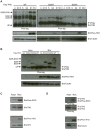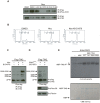Cell cycle regulated phosphorylation of the telomere-associated protein TIN2
- PMID: 23977114
- PMCID: PMC3745427
- DOI: 10.1371/journal.pone.0071697
Cell cycle regulated phosphorylation of the telomere-associated protein TIN2
Abstract
The protein TIN2 is a member of telomere-binding protein complex that serves to cap and protect mammalian chromosome ends. As a number of proteins in this complex are phosphorylated in a cell cycle-dependent manner, we investigated whether TIN2 is modified by phosphorylation as well. We performed phospho-proteomic analysis of human TIN2, and identified two phosphorylated residues, serines 295 and 330. We demonstrated that both these sites were phosphorylated during mitosis in human cells, as detected by Phos-tag reagent and phosphorylation-specific antibodies. Phosphorylation of serines 295 and 330 appeared to be mediated, at least in part, by the mitotic kinase RSK2. Specifically, phosphorylation of TIN2 at both these residues was increased upon expression of RSK2 and reduced by an inhibitor of the RSK family of kinases. Moreover, RSK2 phosphorylated TIN2 in vitro. The identification of these specifically timed post-translational events during the cell cycle suggests a potential mitotic regulation of TIN2 by phosphorylation.
Conflict of interest statement
Figures



Similar articles
-
p90 ribosomal S6 kinase and p70 ribosomal S6 kinase link phosphorylation of the eukaryotic chaperonin containing TCP-1 to growth factor, insulin, and nutrient signaling.J Biol Chem. 2009 May 29;284(22):14939-48. doi: 10.1074/jbc.M900097200. Epub 2009 Mar 30. J Biol Chem. 2009. PMID: 19332537 Free PMC article.
-
TIN2 is a tankyrase 1 PARP modulator in the TRF1 telomere length control complex.Nat Genet. 2004 Jun;36(6):618-23. doi: 10.1038/ng1360. Epub 2004 May 9. Nat Genet. 2004. PMID: 15133513
-
Phosphorylation of p90 ribosomal S6 kinase (RSK) regulates extracellular signal-regulated kinase docking and RSK activity.Mol Cell Biol. 2003 Jul;23(14):4796-804. doi: 10.1128/MCB.23.14.4796-4804.2003. Mol Cell Biol. 2003. PMID: 12832467 Free PMC article.
-
Two widely used RSK inhibitors, BI-D1870 and SL0101, alter mTORC1 signaling in a RSK-independent manner.Cell Signal. 2015 Aug;27(8):1630-42. doi: 10.1016/j.cellsig.2015.04.004. Epub 2015 Apr 16. Cell Signal. 2015. PMID: 25889895
-
Phosphorylation of phosphatase inhibitor-2 at centrosomes during mitosis.J Biol Chem. 2003 Jul 11;278(28):26015-20. doi: 10.1074/jbc.M300782200. Epub 2003 Apr 15. J Biol Chem. 2003. PMID: 12697755
Cited by
-
The C-Terminal Extension Unique to the Long Isoform of the Shelterin Component TIN2 Enhances Its Interaction with TRF2 in a Phosphorylation- and Dyskeratosis Congenita Cluster-Dependent Fashion.Mol Cell Biol. 2018 May 29;38(12):e00025-18. doi: 10.1128/MCB.00025-18. Print 2018 Jun 15. Mol Cell Biol. 2018. PMID: 29581185 Free PMC article.
-
TIN2 Functions with TPP1/POT1 To Stimulate Telomerase Processivity.Mol Cell Biol. 2019 Oct 11;39(21):e00593-18. doi: 10.1128/MCB.00593-18. Print 2019 Nov 1. Mol Cell Biol. 2019. PMID: 31383750 Free PMC article.
-
Acute telomerase components depletion triggers oxidative stress as an early event previous to telomeric shortening.Redox Biol. 2018 Apr;14:398-408. doi: 10.1016/j.redox.2017.10.004. Epub 2017 Oct 7. Redox Biol. 2018. PMID: 29055871 Free PMC article.
References
-
- Loayza D, De Lange T (2003) POT1 as a terminal transducer of TRF1 telomere length control. Nature 423: 1013–1018. - PubMed
-
- Houghtaling BR, Cuttonaro L, Chang W, Smith S (2004) A dynamic molecular link between the telomere length regulator TRF1 and the chromosome end protector TRF2. Curr Biol 14: 1621–1631. - PubMed
-
- Kim SH, Beausejour C, Davalos AR, Kaminker P, Heo SJ, et al. (2004) TIN2 mediates functions of TRF2 at human telomeres. J Biol Chem 279: 43799–43804. - PubMed
-
- Ye JZ, Donigian JR, van Overbeek M, Loayza D, Luo Y, et al. (2004) TIN2 binds TRF1 and TRF2 simultaneously and stabilizes the TRF2 complex on telomeres. J Biol Chem 279: 47264–47271. - PubMed
Publication types
MeSH terms
Substances
Grants and funding
LinkOut - more resources
Full Text Sources
Other Literature Sources
Molecular Biology Databases
Research Materials
Miscellaneous

